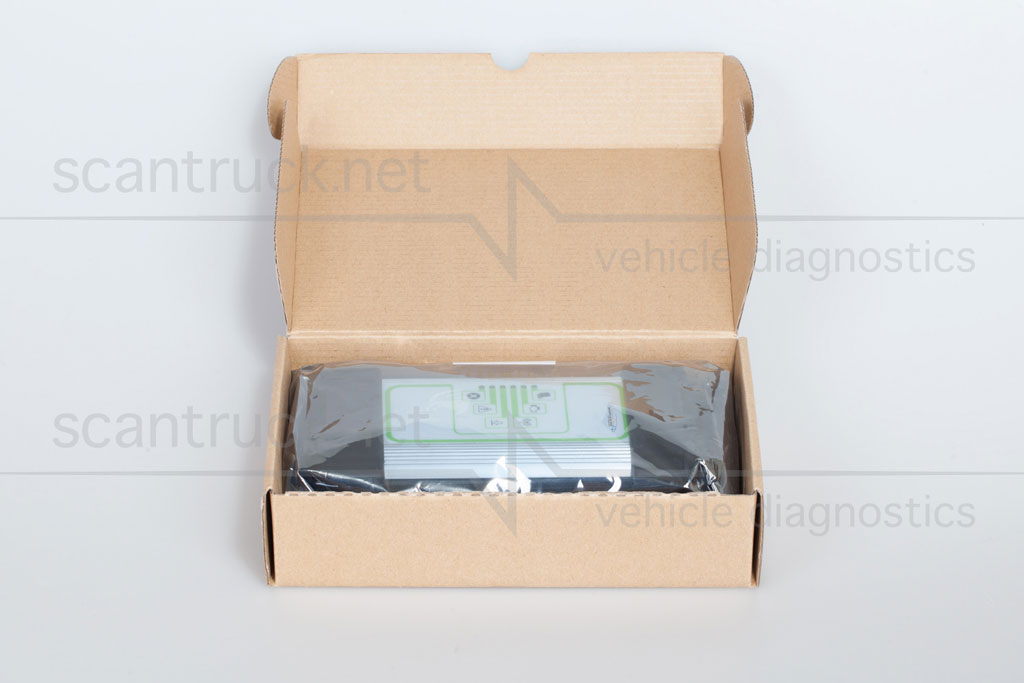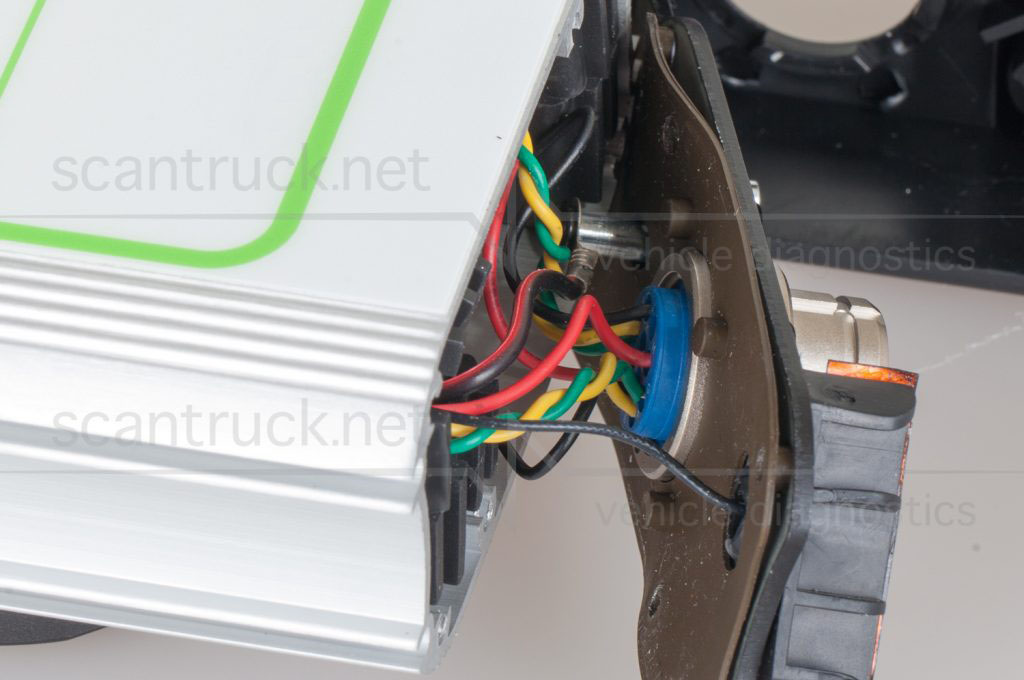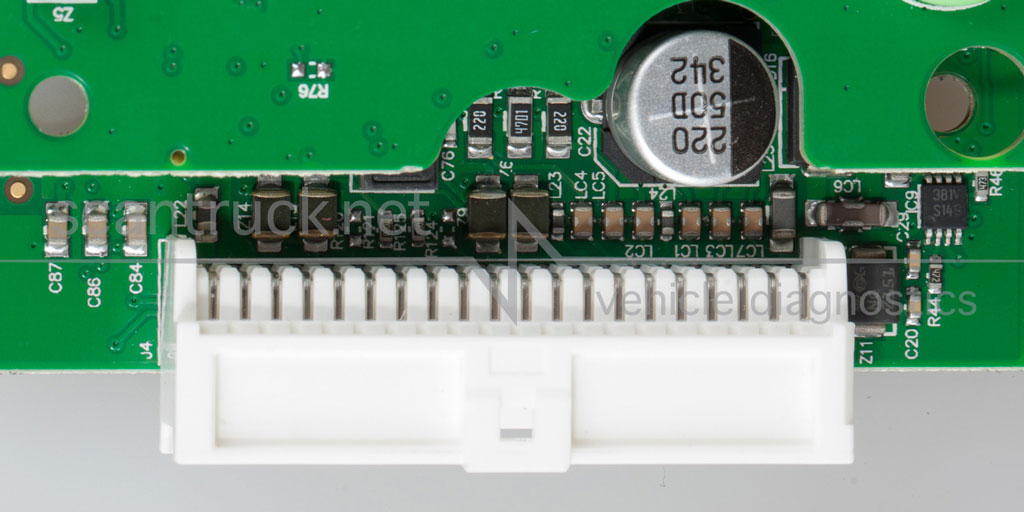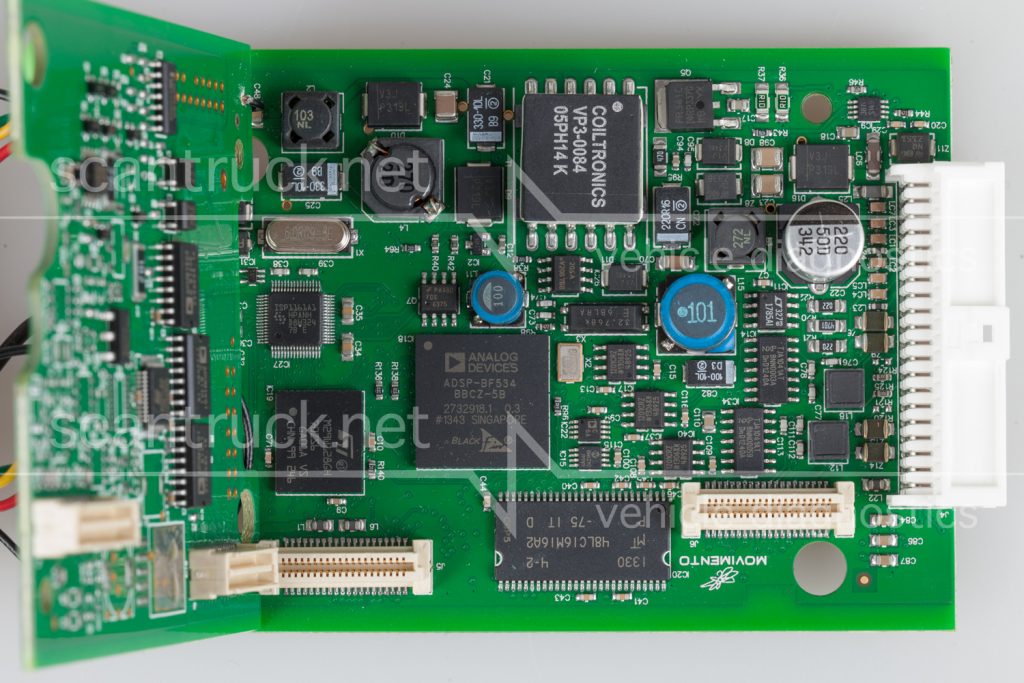Vocom 88890300 diagnostic adapters comparison
The Scantruck Laboratory runs a comparative study of genuine and Chinese copies of diagnostic tools. We hope our short review will help you to figure out whether the device is worth a purchase. This time we have decided to examine the Vocom 88890300 diagnostic adapter. The tool is used for diagnosing trucks, buses and various specialty machines. The selection of accessories for the adapter depends on the make of a vehicle you need to diagnose.

Table of Contents

Take notice that a strap is loosened.

In spite of the fact that the devices look identical, the original model looks rather more presentable than its Chinese clone due to a proper strap.
It’s hard enough to distinguish between the two devices if unpacked, but still you may find some differences to disclose the fake even without disassembling the housing.
1. PACKAGING
If the packages had slight difference, we could omit this section, but there is still room for complaint.


The copy’s box is larger than the original’s one 2-3 times.


The only label on the box contains unreasonably little information on what is inside it.
The label holds information on a serial number, name, certificates, и etc.
Opening the boxes.

As you see, the box is much larger than the device itself, and there is enough unfilled empty space within. The peripherals are just tossed every which way. This may cause damage to the device during transportation.
The box is packed with a cable and a CD (software) in addition to the device.

The box comes up to the device size.. But how can it be otherwise?
There is nothing in the box but the device itself as accessories (cables, adapters) and software are supplied separately.

Software CD.
Taking contents out of the box.

The device is packed in a common zip-lock plastic bag.

The device is packed in an anti-static sealed bag.
The bag has a label with a serial number.


This is how the original accessories look. Certainly, the bag must be sealed.
2. DEVICE VIEW
It is impossible to convey comparisons in such format, but the pungent smell of rubber got into the nose when we opened the package with the Chinese clone. It must be noted that it wasn’t a well-known smell of rubber, but a mixture of chemical odors, which made the process of disassembling rather unpleasant.

The rubber parts produce a persistent unpleasant odor.

The rubber parts of the original are almost odorless.

The strap is loosened and that makes the device a bit unhandy to use.

The device comes with the Velcro strap adjustable to required length.


Fitted with the rubber capto protect the connector against dust and dirt.

There is a flaw on the rubber part – the photo illustrates a minor crack.
Removing the rubber parts.

The walls for plugging connectors are made of the galvanized iron and that indicates the punching edges can be exposed to corrosion.
The self-tapping screws to mount the walls are smaller than in the original. When disassembling the housing, some of them overtwisted and that means the wall is held on fewer number of screws and thus mounting is less reliable.

The walls are anodized after punching. Besides, the rubber gaskets are fitted between the wall and housing, as well as between the connector and the wall to provide moisture protection.

There is no Wi-Fi antenna and thus the module is not supplied.


The connector is from other manufacturer. Most likely, it’s a custom-made copy of the original.

3. DISASSEMBLING THE HOUSING
The interior part turned out to look much more lamentable than the outside. It’s no laughing matter, the Chinese fake lacks 80% of the wires to the connector pins available in the original. Even those who are not versed in electronics can understand that there is nothing similar in the functionality of devices.



Note that the wires are not pair-twisted as in the original device. And that may produce failure in USB operation.
The connector itself differs from the original one. The pins are not isolated from each other. It shows that contacts might close if a wire thread gets there as a result of careless assembling. After all, it may happen not right away, but, for example, while in operation.
No ground.

As expected, the single wires are pair-twisted.
The pins are isolated from each other, so two contacts touching is minimized.
Grounding busbar is available.
When disassembling the housing, a wire in the Chinese clone came off, making the thread just break in two. It says much about the quality of the material used, and soldering is not up to the mark either.
The photo below shows both devices with no housing. You see that the original device is encased a special rubber box.

The device printed circuit board has no protection.

The device board is not merely moistureproof (case, housing gaskets), but also shockproof due to the rubber box.

The scratches inside the housing indicate that this part was additionally ground with emery. Obviously, the holes for indicators were made using a blunt drill which left large burrs. This is one of the examples of a flaw which was eliminated manually.
The most brilliant thing is that the board is inserted into a groove. But as the board size does not match the housing size, it is fixed with small drops of glue. Just imagine, the board will come off with time and move inside the housing. Nothing serious? No, but keep in mind that the LEDs will be forced to move out of their position and produce signals from wrong holes. The worst thing in this case is that you may be unaware of the fault and keep working with an inadequate device.
4. REVIEWING THE BOARD
While stripping down the Chinese clone, we found out enough faults, so that it’s time to draw the conclusion. But we are not intended to stop half-way.
Even the outward view of the boards demonstrates that the Chinese clone and the original device are not alike. Yet, for the reason that the original unit holds two boards, whereas the clone has one board. We have already noted earlier that not all connector pins are connected to the board in the Chinese version. There is some earthly reason to do so. The board lacks some components, so there is nothing to connect.



There is a lack of many components.
We found out that the Chinese board has an offbeat copy protection – all data in the integrated circuit packages is erased to prevent the device against copying by other Chinese!
All the board is smeared with the glue meant to be in another place to stick the board in the housing.

Battery, Wi-Fi module, memory card slot, clock quartz.
As you see, the Chinese not only copied the board, but completely modified it, disposing of all “needless” units.

Chinese QC. For all the board is marked as “OK”, we are of opposite opinion and know that it is far from being OK.

European QC.

The device is fitted with the LEDs of wide light dispersion. Taking into account the space to the housing, it is no wonder that the indicators are made worse than in the original. In some cases it is hard to figure out what signal lights.

The device is equipped with the narrow beam lensed LEDs. And considering that the rubber box is provided with a single tunnel for each LED, the indicators operate properly.

The connector is simplified, such connection is less fail-safe.


The board inductors are of smaller size, and consequently of smaller rating.
The resistor and transformer are different from those in the original printed circuit board. Obviously, they used the components from other manufacturer, with lower price and thus of poor quality (so defective products are most likely to come about).
Judging by the fact that excessive residue is spread in some areas, these components are soldered manually. It’s usually done with high defect rate, when defective components need to be resoldered.
The board has minor traces of flux. These flux spots may cause oxidation.
The aluminium shavings can be noticed on the board. Remember the LED holes? That may cause short-circuit.

CONCLUSION
After comparing the original diagnostic adapter Vocom 88890300 and its Chinese clone, our findings on the copy can be the most deplorable. In spite of the formal resemblance between the devices, we can safely summarize that they are not alike, broadly speaking, they are not twins or even cousins. The Chinese best managed to reproduce formal resemblance, but, to be honest, they saved on the strap and the connector cover. The device turned out to be quite dissimilar to the original inside. At a glance it is apparent that the Chinese model did away with the additional features and notably simplified the board, probably, counting themselves smarter than the European engineers. But we have doubts not only about the reliability and functionality of the Chinese forgery, but also abouthow it performs its main functions.
Hope, now you get the idea why some devices which seem quite identical are offered at a lower price. It will be more frustrating if you buy such fraud at the price of the genuine device. So, we believe that our short review will be of service to avoid a slip-up. In fact, what the Chinese clone does really well is imitate the original Vocom 88890300.




 Русский
Русский العربية
العربية Français
Français Español
Español Türkçe
Türkçe